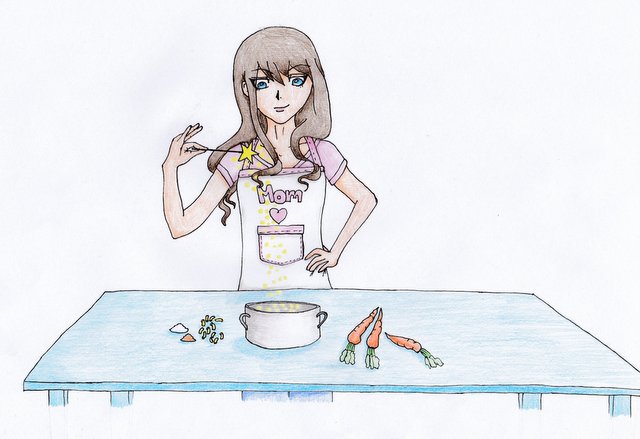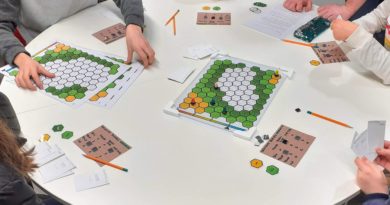We Are What We Eat
I am currently reading the book that won the Food Book of the Year Award this summer: What to Eat? Ten Chewy Questions About Food. It addresses key questions about the whole supply chain operation, such as how to get nutrition and enjoyment from food in an urban lifestyle without wrecking the environment. At the same time, the author, Hattie Ellis, seems to understand that as a working woman with a moderate social life, I simply do not want to spend hours preparing meals, planning when to shop for crucial ingredients and spending every evening at home in my kitchen. It is possible to be a mother and produce healthy, interesting meals in no more than 30 minutes every evening. It can still be a pleasure to indulge in domestic goddess status when I produce an amazing meal once in a blue moon. And the point of food is not just the taste, but also my mood during preparation and the atmosphere around the table while it is consumed. Eating is a social occasion!
First, a word about processed food: our teeth are made to chew. Processed food has been altered, and is often processed quickly by our bodies, meaning that it impacts digestion in a negative way. Instead, go natural: keep skins in your mashed potatoes and on your apples, and avoid meat in artificial casing, such as salami and sausages. Think of the salt content and additives that enable processed food to survive so long in packets without going off. Get your kids into eating versions of what you like to eat; never eat kiddie food to save time. Furthermore, my life is too short to cook one meal for kids and another for the adults. (Really, some people do that!)
Here are a few of Hattie Ellis’s lessons from her research on food, plus a few of my own tips from living in Switzerland for 11 years.
Healthy breakfast habits: A cooked breakfast does not have to be a fry-up. Scramble an egg and put it into a sandwich. Give kids the choice of cheese slices or mozzarella fingers (in the cheese section in Migros). A toasted sandwich is better than a breakfast bar if you are in a hurry. Stop buying sweetened cereal, even if it has been a staple in your house for ten years! As the person who shops, YOU are in charge of what the kids eat. Cut up a piece of fruit every morning and eat it with gusto yourself even if no one else does; they will come round sooner or later. Convince your family that the best gift Switzerland can give you is a taste for Birchermuesli. Find a brand of muesli you like, add delicious fruit, nuts, seeds (a mixed bag of seeds is available in Migros next to the cereals), yoghurt and a dash of milk; leave it to soak while you make the tea or coffee, and enjoy!
Two great ideas: bring back large boxes of Quaker Oats “Oat So Simple” two-minute porridge (original variety in individual packets) from other countries such as the U.K. Microwave in two minutes and add cold jam or cream. Also, Coop in Zurich sells a new Naturaplan “Red Fruit Knuspermüesli” with red berries. It’s quick and healthy, if you use only two spoonfuls with yoghurt and all the fresh trimmings listed above.
Fish. Do not be discouraged if you don’t recognise the fresh fish available in the shops. Be adventurous and go beyond the five mass-farmed familiars – tuna, prawns, salmon, cod and haddock (in EU countries). In restaurants, order the catch of the day. Note down the names of unfamiliar fish in different languages as you travel.
Idea: Stick warm sushi rice, cucumber, soy, crabsticks or whole fresh fish and mayonnaise into a bun or a half piece of sushi seaweed – 15 minutes to cook the rice, 10 to cool it down and assemble the rest, two minutes to make your Japanese hand rolls.
Meat: Eat organic meat, limited to once or twice a week, and resist using meat as a convenient protein. Transform it into the luxury it really is, in food chain terms. Go to the butcher instead of a supermarket and ask them to cut off rinds and excess fat. Do not believe what it says on the packaging in supermarkets.
Idea: Eat rabbit and venison, which are local, fresh and recognisable. Do not shy away from the fact that meat comes from animals. Get your children to respect the implications of what they are eating and contribute to reducing over-consumption.
Which oils and fats? Olive and rapeseed (canola) oils for cooking, nut oils for dressings and sauces. Avoid sunflower oil, as it has so little Omega 3.
How to shop? Buy locally and in season. Don’t avoid misshapen or rough-skinned apples; they probably have been grown with fewer poisonous pesticides. Be adventurous and eat a range of varieties. Ask sellers in markets where the fruit trees are, and show your children on a map. The tastes they have for food as children determine their health at 50.
Vegetables are cheaper to buy in quantity than fruit. Get your children to eat a wide range of vegetables, as their palates change as they grow up and need constant good influences. A diverse diet also reduces the risk of heart disease, according to the latest research. Go to farmers’ markets and stop the car at farms in Switzerland with farm shops. Cook more vegetables than you need and keep two types already prepared in the fridge to supplement different meals.
At the butcher, find locally grown meat and cheaper cuts of organic. Ask for cooking tips and get them to prepare the meat for you. This way, you will not be paying for the packaging, and you will be obliged to use the German painstakingly learnt in your classes.
What about the “five a day” fruit and vegetables mantra? This is useful because it enables us to keep a mental track of which different fruit and veggies we eat throughout the day, in digestible quantities. Regardless of what an “official” portion is in the E.U., most adults and children can judge how much of each type of food will complement their other foods. Whether a whole apple or two apricots, each counts as a portion. Eating a mixed salad as a starter before your main course in Switzerland is a good local habit to acquire while you live here. Local fruit is sold cheaply in season here and can be bought in large quantities, cooked gently, and made into jam or into desserts with no added sugar. Add crème fraîche to plums and quark to pears. Always have three different types of fruit and vegetables in your fridge. Offer children pepper and cucumber sticks and carrot coins before meals instead of crisps and processed snacks.
Thanks to Hattie Ellis for being an inspiration. Goodness knows, I need it!
By Monica Shah
As well as being passionate about good food and drink, Monica Shah is founder and head of a nursery, preschool and kindergarten for international families in the city of Zurich. www.childrenfirst.ch
Illustration by Lara Friedrich
Currently a senior at the Kantonsschule Ausserschwyz in Nuolen, Lara is a freelance illustrator for Mothering Matters and a demo singer for the songwriter Kate Northrop. She has also written an article for the newspaper March-Anzeiger and is bilingual in English and German.
* Book: What to Eat? Ten Chewy Questions About Food, by Hattie Ellis. Portobello Books, 2013.





For quick cooking porridge oats we buy ”Zarte Haferflocken” from the local supermarket. A bowl takes circa 3 mins to cook in the microwave.